
|
Roy Ayers and The Original Superstars of Jazz Fusion
Presented by R.E.M.G. and Toronto Downtown Jazz |
| November 16, 2006 • Phoenix Concert Theatre • Toronto |
|
|
Fanciful Funk-Fusion From The Ubiquitous Roy Ayers
by Paul J. Youngman with photos by Roger Humbert |
| The Original Superstars of Jazz Fusion concert with Roy Ayers, Lonnie Liston Smith, Jean Carne, Wayne Henderson, Bobbi Humphrey, Ronnie Laws & Jon Lucien was a tremendous success. The fusion occurred between the promoters, a co-production of Toronto Downtown Jazz and REMG Productions and the audience, a diverse mix of young and old. The young people were singing along to songs that were written in the 70s that are among some of the most popular samples added to the hip-hop, rap and dance music of today. The atmosphere at the theatre was electric. An audience of close to three hundred came to groove on jazz-inspired funk, soul and R&B music. They got all of that and much more.
Roy E. Ayers was born on October 9, 1940 in Los Angeles, CA. He grew up in a musical family where his father played trombone and his mother piano. At the age of five, he received a vibraphone as a gift from the famous vibes master Lionel Hampton. As his interest for the vibraphone grew so did his involvement in the west coast jazz scene. He started playing with artists like Chico Hamilton and the Gerald Wilson Orchestra (1965-66). In 1966, he joined up with Herbie Mann, an association that lasted four years. During this period, he also became interested in musical forms other than the be-bop he grew up with. After contributing on Mann's hit album, Memphis Underground, and recording three of his own solo projects on the Atlantic label, with Mann as producer, Ayers left Mann's group in 1970 and moved to Manhattan, NYC. In Manhattan, he formed his own group, Roy Ayers Ubiquity.
|
|
With Ubiquity, Ayers recorded several albums for Polydor using legendary musicians such as Sonny Fortune, Billy Cobham, Omar Hakim and Alphonze Mouzon. From the beginning, Ubiquity was a fusion of R&B, jazz and rock, influenced by artists such as piano wizard Herbie Hancock’s Head Hunters sextet and the electric side of trumpeter Miles Davis. The band lost much of its jazz influence and instead began to create its own blend of R&B, funk and 70s dance, generating commercial successes. The greatest success came with the classic tune "Running Away" from the 1977 album Lifeline. Another Ubiquity hit was the tune, "Everybody Loves The Sunshine," from the album of the same name released in 1976. Ayers and The Ubiquity Band performed a great version of the song this night that featured an amazing drum solo by Lee Pearson.
The Phoenix Concert Theatre is 18,000 square feet of historical Toronto architecture encompassing three distinct environments. The Main Room where the Roy Ayers concert took place, features one of the city’s largest dance floors, five bars (including a 50-foot marble bar, nice for taking notes), a massive stage (and full concert facilities), a giant projection screen, and one of the largest mirror balls in Canada, so I’ve been informed. "Le Loft," which overlooks the main room and was closed for the Roy Ayers concert, features an overhanging balcony which stretches the entire width of the club. The loft is a lounge with seating for over 100 and has its own separate bar. The Parlour, accessible from the main room and the front entrance, features a separate sound system, a separate dance floor, another bar, lounge seating and four pool tables.
|
|
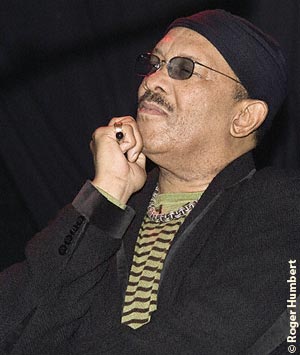
Roy Ayers |
|
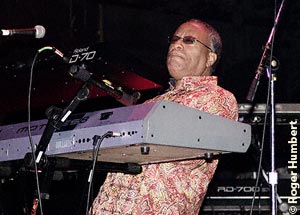
Lonnie Liston Smith |
|
|
| Lonnie Liston Smith was the first superstar to shine. Taking to the organ and backed up by The Ubiquity Band, he proceeded to produce some eerie sounds, effectively complemented by lights casting a hot red glow over the stage. With a pounding, sensual beat driving the rhythm the crowd moved en-masse to the front of the stage. There were no chairs; it was a standing, swaying, motivated crowd. Bass player Donald Nicks, playing an electric bass in a classical style, laid down a funk pattern, a syncopated beat that the drummer played on top of at double time pulse. A dynamically energetic heavy rhythm section pushed each song along with joyful abandon from beginning to end.
The second tune was very mellow, with a calypso feel to it. Lonnie Liston Smith produced sounds similar to steel pans from the organ on this one. The song made way for Bobby Humphrey, who played a Lionel Ritchie song, “Hello”, which built in intensity, spurred on by the boogie-woogie piano of Mark Adams. The next song was a remix of a 1973 classic, “Hard Working”. Humphrey has a pleasing flute style, she has great sustain and pulled off some very fast runs. On the last chorus, Humphrey took a well-composed extended solo that was very nice and set the mood for the next song.
|
| At this time, Roy Ayers and Jean Carne joined Humphrey on stage. Lonnie Liston Smith had departed after his song to make way for Humphrey. The show progressed with The Superstars of Jazz Fusion making appearances by themselves or in various combinations. Ayers stayed on stage for most of the show, playing vibes, sometimes utilizing a single mallet technique and at other times a double mallet technique, as well as vocalizing. Jon Lucien was introduced to the stage for the sixth song. Dressed in a rose-coloured suit with black shirt he commanded attention, looking and sounding sharp. Lucien is a crooner with a deep smooth voice. He sang and scatted in a very percussive style, playing off the bass player’s rhythm. The second number he performed was a Jobim piece, a ballad that he sang with passion.
Jean Carne would come back out and sing her hit single of the 70s, “Don’t Let It Go To Your Head”, as well as “Thank You”. She brought out Vincent Wolfe, a Toronto native, who assisted with back-up vocals. Carne has a voice that reminds me of Tina Turner with some Donna Summer influences. Carne was with Earth, Wind & Fire as a back up vocalist in the early 70s.
The instrumental component of the show took over at this point with the introduction of saxophone great Ronnie Laws of Earth, Wind & Fire fame. He would play soprano on “Well You Needn’t”, performing a very elegant solo with some audience-supplied percussion. The full band was cookin’ on this number.
A highlight of the concert was Wayne Henderson and Laws, on tenor saxophone, performing together. Henderson on slide trombone, with an upturned bell similar to Dizzy Gillespie’s trumpet. Wayne Henderson is a multi-instrumentalist and producer/composer with a dynamic trombone style. Henderson was the leader of the legendary Jazz Crusaders and was responsible for many hit-recordings, since the group’s inception in 1961.
Henderson would also play valve trombone. He has an energetic stage presence that picked up the pace, driving the audience to participate with some great vocalizing in “Keep That Same Old Feeling.” The complete ensemble was on stage for the finale, they had the audience happy and near exhaustion. The combination of standing, singing, drinking, dancing, clapping and generally grooving to The Original Superstars of Jazz Fusion had taken its toll, the audience participation in the final chant was mediocre at best but the Superstars of Jazz Fusion graciously came back to the stage for an encore number.
I look forward to many more fusion-inspired shows at The Phoenix Concert Theatre. Thanks to the co-production companies and staff, especially REMG Productions’ on-site promoter Neil. The fusion of the music of yesterday, today and tomorrow is what keeps jazz alive.
|
|
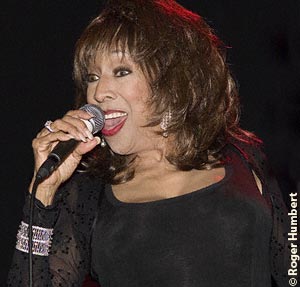
Jean Carne |
|
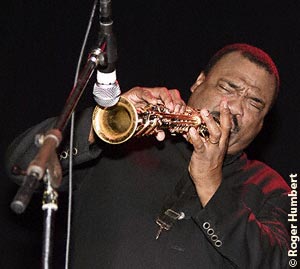
Ronnie Laws |
|
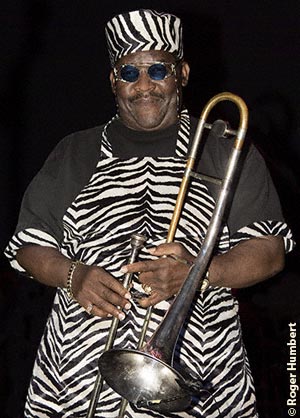
Wayne Henderson |
|
|
|
|
The Original Superstars of Jazz Fusion
Roy Ayers – vibes, vocals
Jean Carne – vocals
Wayne Henderson – trombone, vocals
Bobbi Humphrey – flute, vocals
Ronnie Laws – saxophone
Jon Lucien – vocals
Lonnie Liston Smith – keyboards
The Ubiquity Band
Mark Adams – keys
Donald Nicks – bass
Lee Pearson – drums
and
Vincent Wolfe – vocals
www.royayers.com
|
|
|
|
|
|
|






